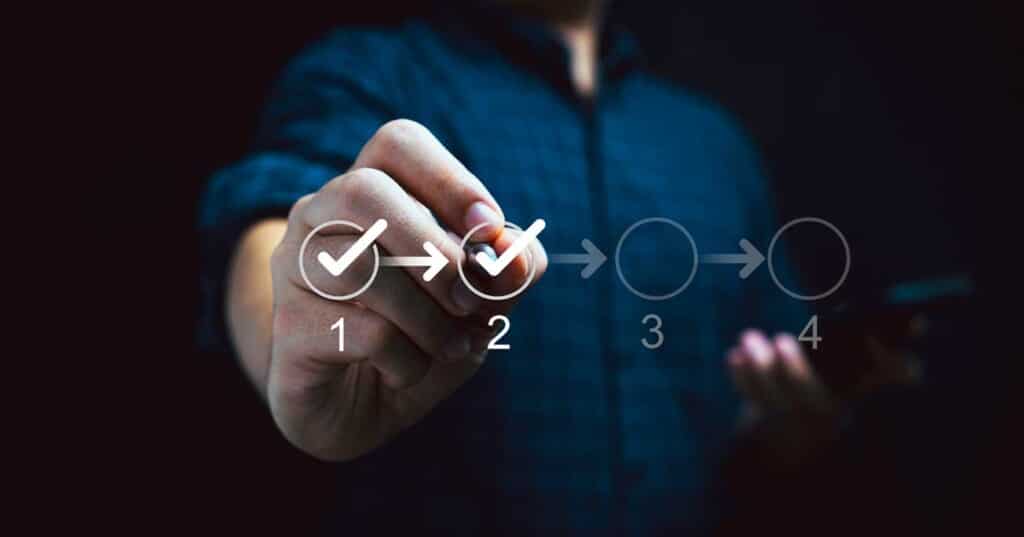
Why we place so much importance on the website discovery phase
Table of Contents
TLDR
A well defined strategy during the early discovery and planning phases significantly streamlines design and development, reducing costs.
By setting clear objectives, understanding user requirements, and precisely defining the project scope from the start, the need for later adjustments or refactoring is minimised.
This proactive approach aligns design choices with project goals and focuses development efforts, reducing the chance of expensive delays or the need to overhaul key project components later on.
Efficient resource use and improved project quality result in a more unified, user-focused product.
Listen to the Article
The voice and reading of this article were created with artificial intelligence.
The Importance of our Website Discovery Phase

At the outset of any web design project, we prioritise the discovery phase as our roadmap. This isn’t just a preliminary step; it’s a deep dive into understanding our client’s aspirations and aligning them with their audience’s needs and preferences. This phase ensures every aspect of the project scope, from the brand identity to the technical SEO, is grounded in strategy and insight.
Why our Web Discovery Phase Is So Important
It’s where we lay the groundwork. It’s about getting to the heart of what makes a brand tick, pinpointing precisely what the target audience seeks, and how we can bridge that gap through design, content, imagery, and functionality. This approach isn’t just beneficial; it’s essential. Our experiences, backed by case studies, have shown that a well-executed discovery phase leads to a final product that resonates more deeply with the user and stands out in a crowded market.
A well-defined strategy in the early stages of a project, particularly during the discovery and planning phases, plays a crucial role in streamlining the design and development processes, thereby reducing overall costs.
By establishing clear goals, understanding user needs, and defining the scope accurately from the outset, our design and development teams can minimise the need for significant changes or refactoring later in the project lifecycle. This foresight ensures that design decisions are aligned with the project’s objectives and that development efforts are more focused and efficient.
As a result, the likelihood of encountering costly delays or the need to revisit and revise fundamental aspects of the project during the more resource-intensive phases is significantly diminished. This approach optimises resource allocation and enhances the project’s overall quality and effectiveness, ultimately leading to a more cohesive and user-centric product.
• • •
The Essence of the Discovery Phase

Defining the Project Discovery Phase
In web design and development, the discovery phase is the compass guiding every aspect of a project. This initial step is crucial, laying the groundwork for a successful outcome. It’s not just about ticking boxes; it’s about thorough exploration and understanding. Please think of us as a sponge at this stage, absorbing as much information as you can give or tease out through our discovery workshops. The more information you can provide, the stronger our delivery will become.
What our Discovery team will ask
The discovery phase encompasses a wide array of elements, each critical in its own right. Let’s break it down:
- Brand Identity: Understanding the brand’s ethos, values, and vision is paramount at the start. This isn’t just about logos or colour schemes; it’s about the message the brand wishes to convey and how it wants to be perceived by its audience.
- User Needs and Preferences: Knowing the audience is key. What are their behaviours, needs, and challenges? How can the website address these? This knowledge ensures the final product resonates with and serves the intended users effectively.
- Technical Aspects: This is where the rubber meets the road regarding functionality. Search engine optimisation strategies are outlined to ensure visibility in search engine results. At the same time, page speed considerations are addressed to provide a seamless user experience. These technical details are critical in ensuring the site attracts visitors and keeps them engaged.
• • •
Brand Discovery

Understanding the Brand Identity
I’ve learned that understanding a client’s brand is not just the first step; it’s the most pivotal. Brand discovery goes beyond mere aesthetics; it’s about grasping the essence of who they are, their mission, strengths, weaknesses, and unique personality.
- Logo Design – A logo is not just a visual mark; it’s a fundamental expression of a brand’s identity, values, and mission. During the discovery phase, dedicating time to logo design is crucial because it sets the tone for the entire project. A well-crafted logo encapsulates the essence of a brand and communicates it effectively to the target audience, establishing an immediate connection and recognition. This phase allows for a deep dive into what the brand stands for, its positioning in the market, and how it wishes to be perceived by its audience, making a logo design a pivotal moment in laying the foundation for a brand’s visual identity and overall strategy.
- Defining the Tone Voice – A well-defined tone guides all content creation, ensuring consistency across marketing materials, web content, and social media interactions. It’s about choosing words, phrases, and a style that resonates with the audience, making the brand relatable and distinctive in a crowded market. Whether professional and authoritative, friendly and conversational, or bold and quirky, the tone of voice sets the stage for how a brand communicates its message and engages with its audience, laying the groundwork for meaningful interactions and long-term loyalty.
- Content Discovery – Involves a detailed exploration of what content is necessary, from text and images to videos and interactive elements, to effectively communicate the brand’s message and meet user needs. This stage is about mapping out the content requirements, understanding the audience’s information needs, and identifying gaps in existing content. It’s not just about what content to create but how it fits within the user journey, enhancing engagement and guiding users towards desired actions. Through content discovery, we lay a foundation for relevant, valuable content strategically designed to support the project’s objectives, ensuring a cohesive and impactful user experience.
- Image Discovery – The impact of imagery and visual identity on brand perception and user engagement has become apparent. Selecting imagery that aligns with and amplifies a brand’s identity is a delicate art. It’s about more than just aesthetic appeal; it’s about telling a story, evoking emotions, and building a connection with the audience.
- User needs and preferences – Engaging in deep conversations with our clients is essential to truly grasp and align a brand’s identity with user needs and preferences. Through these discussions, we aim to unearth the core values, vision, and mission that define their brand. This process involves asking targeted questions that delve into the brand’s history, market positioning, and the unique value it offers customers. We also explore the brand’s current perception among its audience and its aspirations for future growth. By understanding these elements, we can tailor our approach to meet the business objectives and resonate with the end-users’ expectations. This collaborative dialogue ensures that the resulting strategies reflect not only the brand’s essence but are also user-centric, catering to their target audience’s specific needs and preferences. Through this synergy between brand understanding and user insights, we pave the way for creating meaningful and impactful brand experiences.
• • •
Competitor Benchmarking

Competitive Insights
The art of competitor benchmarking and SEO analysis has proven to be a cornerstone for many of the successes we have had at our agency. Researching and auditing competitors’ digital presence, examining their brand positioning, SEO strategies, page speed, and mobile-friendliness opens up a world of insights.
What do we look at?
- Brand Positioning – involves understanding the brand’s audience, analysing competitors, and defining what makes the brand distinct—whether through customer service, product quality, convenience, or innovation. Effective brand positioning goes beyond mere differentiation; it seeks to create a brand the first choice for consumers, ensuring it remains top-of-mind and relevant in a crowded market.
- Content – To examine a competitor’s tone of voice, messaging, and imagery, it’s important to analyse how these elements communicate their brand identity, differentiate from others, and connect with their target audience. This involves looking at how they use language and visual elements across various platforms, the consistency of their messaging, and how effectively they engage their audience. By understanding these aspects, you can identify gaps in their strategy and opportunities to differentiate your brand, ensuring your messaging and imagery stand out and resonate more authentically with your desired audience.
- Search Engine Optimisation – Evaluating competitors’ SEO strategies offers invaluable insights, guiding us to refine our own for enhanced online visibility. By scrutinising their keywords, we gain clarity on the terms driving traffic to their sites, uncovering opportunities to compete for the same keywords or identify neglected ones ripe for targeting. Analysing their referring domains reveals the quality and relevance of backlinks, inspiring strategies to bolster our link-building efforts. Observing competitors’ SERP rankings highlights the effectiveness of their SEO tactics and sets benchmarks for our performance. Traffic sources shed light on their most lucrative channels, suggesting areas we might invest in more heavily. Insights into their page speed can underscore the importance of optimising our website’s load time to improve user experience and search rankings. Together, these aspects form a comprehensive understanding of the competitive landscape, enabling informed decisions to outperform rivals in search engine results.
- User Experience -This involves analysing competitors’ offerings, customer feedback, and engagement strategies to grasp what resonates with the audience and where unmet demands might occur. By examining reviews, social media interactions, and user behaviour on competitors’ platforms, we can uncover valuable insights into what users value, dislike, or wish for. This knowledge allows us to tailor our approach, ensuring our products or services meet and exceed user expectations. Ultimately, this deep dive into user preferences aids in crafting a user-centric strategy that stands out in a crowded marketplace, aligning our solutions more closely with what users seek.
• • •
Defining Your New User Experience

Enhancing user experience (UX) has always been at the core of what we do. It’s the bridge between mere functionality and meaningful interaction. Diving into methods like user interviews and feedback surveys has been enlightening and transformational in how we approach design. These tools have opened doors to understanding user needs, preferences, and frustrations, allowing me to tailor designs that resonate on a deeper level.
User Interviews
Conducting user interviews has always been a part of our process. It’s a window into the users’ world, offering unfiltered insights into how they interact with a website. For a recent project for an education charity – this highlighted
- Navigation was not intuitive, and the site structure was ineffective
- Clear and straightforward user journeys were not defined and implemented
- The content was too hard to find and understand
- Identification of personas that were not catered for
The user interviews highlighted a disconnect between what we thought users needed and what they valued. This revelation was a game-changer, leading us to redesign the navigation and prioritise content differently, significantly enhancing user satisfaction and engagement.
Feedback Surveys
Similarly, feedback surveys have been invaluable. They’re like taking the pulse of your user base en masse. In one case, survey feedback pointed to a familiar issue users faced with checkout processes. Addressing this, we streamlined the flow and simplified forms, resulting in a noticeable uptick in conversions. These surveys have underscored the importance of continual listening and adapting, keeping user experience at the forefront of web development.
The Impact on Design
This research is pivotal in designing intuitive navigation and engaging content. Following best practices is one thing, but grounding design decisions in real user feedback takes it to another level. Intuitive navigation isn’t just about ease; it’s about creating a seamless and thoughtful journey.
Engaging content goes beyond being well-written; it’s about speaking directly to the user’s needs, interests, and challenges, making every interaction meaningful. For instance, adjusting the tone and style of the content based on user feedback for a health and wellness website made the brand more relatable and trustworthy to its audience, leading to increased user engagement and loyalty.
• • •
Technical Discovery

Introduction to Technical Assessment
Technical assessment forms the backbone of any successful web project. It encompasses many considerations – from choosing Content Management Systems (CMS) to ensuring GDPR compliance and security measures.
Content Management Systems (CMS)
- Selection Criteria: Choosing a suitable CMS is crucial for both the editing experience and publishing workflows. It should be intuitive for users, offer a range of functionalities, and be scalable to accommodate the project’s growth.
- User-Friendly Interface: A straightforward and efficient editing experience encourages regular content updates and team collaboration.
- Workflow Customisation: The ability to tailor publishing workflows to the project’s specific needs enhances efficiency and control over content release.
- Key Considerations: Ease of use, customisation capabilities, and support for multiple user roles and permissions.
Data Capture and Storage
- Data Handling: Proper mechanisms for capturing and storing user data are essential for personalization and analytics and for complying with data protection regulations.
- Storage Solutions: Consideration of secure, scalable, and cost-effective storage solutions to handle growing data needs.
GDPR Compliance
- Privacy Measures: Ensuring your web project adheres to GDPR and other privacy laws is non-negotiable. It involves transparent data collection policies, user consent mechanisms, and data access and erasure rights.
- Regular Audits: Conducting regular compliance audits to identify and address potential vulnerabilities.
Security
- Protection Measures: Implement strong security measures to protect against data breaches and cyber-attacks. This includes secure coding practices, regular security updates, and the use of HTTPS.
- Regular Security Assessments: Continuous monitoring and testing for vulnerabilities to keep the project secure.
Hosting
- Selection Criteria: The hosting choice can significantly impact your project’s performance and reliability. Consider factors such as uptime, load times, scalability, and customer support.
- Cloud vs. Traditional Hosting: Evaluate the benefits of cloud hosting, such as flexibility and scalability, against the needs and budget of your project.
A comprehensive technical assessment is indispensable for the success of web projects. Paying attention to these areas can significantly reduce future costs and complexities, ensuring a robust, scalable, and compliant web presence.
• • •
Wrapping Up

The discovery phase has emerged as a preliminary step and the foundation for successful projects. It’s a holistic approach that meticulously prepares a project to meet business objectives, satisfy user needs, and outpace competitors.
Thorough Preparation
Thorough preparation during the discovery phase involves identifying the client’s goals and understanding the competitive landscape. By examining competitors’ strengths and weaknesses, we can carve a niche for our clients that matches their strengths. Additionally, technical assessments like SEO analysis, page speed optimisation, and mobile friendliness are integral to laying a solid foundation for the project. These elements are critical in ensuring the website attracts visitors and provides a seamless user experience.
The Impact of Discovery on Project Success
My experiences have consistently shown that projects backed by an exhaustive discovery phase stand a higher chance of success.
A well-defined strategy during the early discovery and planning phases significantly streamlines design and development, reducing costs. By setting clear objectives, understanding user requirements, and precisely defining the project scope from the start, the need for later adjustments or refactoring is minimised. This proactive approach aligns design choices with project goals and focuses development efforts, reducing the chance of expensive delays or the need to overhaul key project components later on. Efficient resource use and improved project quality result in a more unified, user-focused product.
• • •





